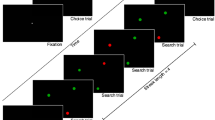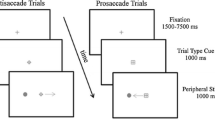Abstract
In two-choice reaction time tasks, participants respond faster when the correct decision switches across consecutive trials. This alternation advantage has been interpreted as the guessing strategies of participants. Because the participants expect that the correct decision will switch across consecutive trials, they respond faster when this expectation is confirmed and they respond more slowly when it is disconfirmed. In this study, we evaluated the veracity of this expectancy interpretation. After replicating a long-lasting alternation advantage in saccadic reaction times (Experiment 1), we show that reducing the participants’ ability to guess with a challenging mental rotation task does not change the alternation advantage, which suggests that expectancy is not responsible for the effect (Experiment 2). Next, we used prosaccade and antisaccade responses to dissociate between the sensory and motor contributions of the alternation advantage (Experiment 3) and we found that the alternation advantage originates from sensory processing. The implications of these findings are discussed with regard to guessing strategies, sensory processing, and how these findings may relate to inhibition of return.



Similar content being viewed by others
References
Abrams RA, Dobkin RS (1994) Inhibition of return: effects of attentional cuing on eye movement latencies. J Exp Psychol Hum Percept Perform 20:467–477
Bell AH, Fecteau JH, Munoz DP (2004) Using auditory and visual stimuli to investigate the behavioral and neuronal consequences of reflexive covert orienting. J Neurophysiol 91:2172–2184
Bertelson P (1961) Sequential redundancy and speed in a serial two-choice responding task. Q J Exp Psychol 13:90–120
Bruyer R, Scailquin JC (1998) The visual sketchpad for mental images: testing the multicomponent model of working memory. Acta Psychol (Amst) 98:17–36
Carpenter RH (2001) Express saccades: is bimodality a result of the order of stimulus presentation? Vision Res 41:1145–1151
Danziger S, Kingstone A, Snyder JJ (1998) IOR to successively stimulated locations in a sequential visual search paradigm. J Exp Psychol Hum Percept Perform 24:1467–1475
Dorris MC, Munoz DP (1995) A neural correlate for the gap effect on saccadic reaction times in monkeys. J Neurophysiol 73:2558–2562
Dorris MC, Munoz DP (1998) Saccadic probability influences motor preparation signals and time to saccadic initiation. J Neurosci 18:7015–7026
Dorris MC, Taylor TL, Klein RM, Munoz DP (1999) Influence of previous visual stimulus or saccade on saccadic reaction times in monkey. J Neurophysiol 81:2429–2436
Dorris MC, Klein RM, Everling S, Munoz DP (2002) Contribution of primate superior colliculus to IOR. J Cogn Neurosci 14:1256–1263
Fecteau JH, Munoz DP (2003) Exploring the consequences of the previous trial. Nat Rev Neurosci 4:435–443
Fectau JH, Bell AH, Munoz DP (2004) Neural correlates of the automatic and goal-driven biases in orienting spatial attention. J Neurophysiol (in press)
Fischer B, Weber H (1993) Express saccades and visual attention. Behav Brain Sci 16:533–610
Fischer MH, Pratt J, Neggers SF (2003) Inhibition of return and manual pointing movements. Percept Psychophys 65:379–387
Hallet PE (1978) Primary and secondary saccades to goals defined by instructions. Vision Res 18:1279–1296
Hays AV, Richmond BJ, Optician LM (1982) A UNIX-based multiple process system for real-time data acquisition and control. WESCON Conf Proc 2:1–10
Ingle D (1973) Disinhibition of tectal neurons by pretectal lesions in the frog. Science 180:422–424
Jarvik (1946) Probability discrimination and the gambler’s fallacy in guessing. Am Psychol 1:453–454
Kingstone A, Klein RM (1993) Visual offsets facilitate saccadic latency: does predisengagement of visuospatial attention mediate this gap effect? J Exp Psychol Hum Percept Perform 19:1251–1265
Kirby NH (1976) Sequential effects in two-choice reaction time: automatic facilitation or subjective expectancy? J Exp Psychol Hum Percept Perform 2:567–577
Klein RM (2000) IOR. Trends Cogn Sci 4:138–147
Lupianez J, Milan EG, Tornay FJ, Madrid E, Tudela P (1997) Does IOR occur in discrimination tasks? Yes, it does, but later. Percept Psychophys 59:1241–1254
Maylor EA (1985) Facilitatory and inhibitory components of orienting in visual space. In: Posner MI, Marin OSM (eds) Mechanisms of attention: attention and performance, vol XI. Erlbaum, Hillsdale, NJ, pp 189–204
Maylor EA, Hockey GRJ (1985) Inhibitory component of externally controlled covert orienting in visual space. J Exp Psychol Hum Percept Perform 11:777–787
Posner MI, Cohen Y (1984) Components of visual orienting. In: Bouma H, Bouwhuis D (eds) Attention and performance, vol X. Control of language processes. Erlbaum, London, pp 531–566
Posner MI, Rafal RD, Choate LS, Vaughan J (1985) Inhibition of return: neural basis and function. Cogn Neuropsychol 2:211–228
Rafal RD, Calabresi PA, Brennan CW, Sciolto TK (1989) Saccade preparation inhibits reorienting to recently attended locations. J Exp Psychol Hum Percept Perform 15:673–685
Rafal R, Egly R, Rhodes D (1994) Effects of IOR on voluntary and visually guided saccades. Can J Exp Psychol 48:284–300
Remington RJ (1969) Analysis of sequential effects in choice reaction times. J Exp Psychol 82:250–257
Sapir A, Soroker N, Berger A, Henik A (1999) Inhibition of return in spatial attention: direct evidence for collicular generation. Nat Neurosci. 2:1053–1054
Saslow MG (1967) Effects of components of displacement-step stimuli upon latency for saccadic eye movement. J Opt Soc Am 57:1024–1029
Soetens E (1998) Localizing sequential effects in serial choice reaction time with the information reduction procedure? J Exp Psychol Hum Percept Perform 24:547–568
Soetens E, Boer LC, Hueting JE (1985) Expectancy or automatic facilitation? Separating sequential effects in two-choice reaction time. J Exp Psychol Hum Percept Perform 11:598–616
Taylor TL, Donnelly MP (2002) Inhibition of return for target discriminations: the effect of repeating discriminated and irrelevant stimulus dimensions. Percept Psychophys 64:292–317
Taylor TL, Klein RM (1998) On the causes and effects of IOR. Psychonom Bull Rev 5:625–643
Taylor TL, Klein RM (2000) Visual and motor effects in IOR. J Exp Psychol Hum Percept Perform 26:1639–1656
Townsend, JT, Ashby FG (1983) The stochastic modeling of elementary psychological processing systems. Erlbaum, Hillsdale
Wright RD, Richard CM (2000) Location cue validity affects inhibition of return of visual processing. Vision Res 40:2351–2358
Wright RD, Ward L (1998) The control of visual attention. In: Wright RD (ed) Visual attention. Oxford University Press, London, pp 132–186
Acknowledgements
This research was supported by operating and equipment grants from the Canadian Institutes of Health Research awarded to D.P. Munoz. Jillian Fecteau was funded with an NSERC Postdoctoral Fellowship. We would like to thank A. Bell, J. Gore, and R. Marino for their helpful comments on an earlier draft of this article and K. Moore and D. Hamburger for their technical support.
Author information
Authors and Affiliations
Corresponding author
Additional information
Jillian H. Fecteau and Crystal Au contributed equally to this work
Rights and permissions
About this article
Cite this article
Fecteau, J.H., Au, C., Armstrong, I.T. et al. Sensory biases produce alternation advantage found in sequential saccadic eye movement tasks. Exp Brain Res 159, 84–91 (2004). https://doi.org/10.1007/s00221-004-1935-9
Received:
Accepted:
Published:
Issue Date:
DOI: https://doi.org/10.1007/s00221-004-1935-9




